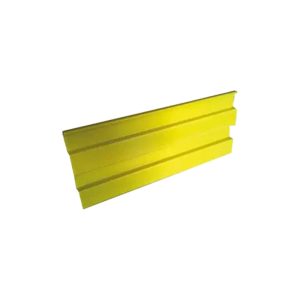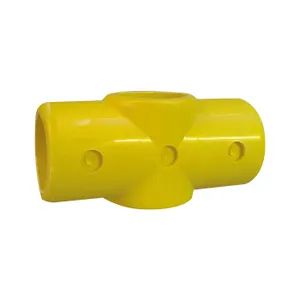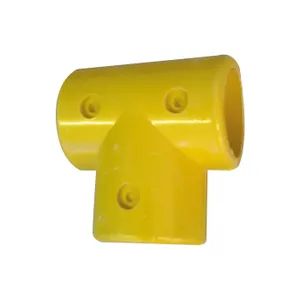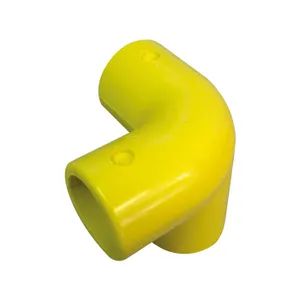Nuestro sistema de pasamanos de GRP se usa a menudo en un pasamanos o barandilla de GRP para continuar el riel central en una esquina de 90° o conectar postes verticales al riel superior, o para unir el riel intermedio al poste final.
Introducción al rendimiento del producto
|
|
El pivote externo de PRFV es un accesorio giratorio en línea versátil, que se utiliza a menudo cuando los ángulos varían en pendientes, escalones y descansos. |
|
La esquina media GRP 116 es una junta de esquina de 90°, que a menudo se usa en un pasamanos o barandilla de GRP para continuar el riel central en una esquina de 90°, pero también se puede usar para construir estructuras rectangulares o cuadradas. El montante pasa verticalmente a través del herraje de PRFV. A menudo se usa con la esquina superior GRP-128. |
|
|
La T corta de GRP 101 es una conexión en T de 90°, que normalmente se usa en un pasamanos de GRP para conectar los postes verticales al riel superior o para unir el riel intermedio al poste final. El tubo no se puede unir dentro de la parte superior del accesorio; la T larga GRP-104 se puede usar como alternativa si es necesario. |
|
El pasamanos GRP Fitting 119 Midrail Cross es una junta de 90° que se usa a menudo para unir el riel central a un poste vertical intermedio en un pasamanos o barandilla de GRP. El montante pasa verticalmente a través del herraje de PRFV. |
|
|
La T larga de GRP 104 es una conexión en T de 90°, que normalmente se usa para conectar postes verticales al riel superior de un pasamanos de GRP. El GRP -104 se puede utilizar cuando es necesario unir dos tramos de tubo dentro de la parte superior del accesorio. |
|
El accesorio GRP 125 es un codo de 90°, que a menudo se usa en un pasamanos o barandilla de GRP para conectar el riel superior al poste vertical al final de un tramo. |
|
|
El GRP 129 es un accesorio en T de 30°, que a menudo se usa en una barandilla o barandilla de GRP para escaleras. |
|
El accesorio 128 Top Corner es de 3 vías. Codo de 90°, normalmente utilizado para unir un poste vertical al riel superior de un pasamanos de PRFV en una esquina de 90°. A menudo se usa con el GRP-116 Mid Corner. |
|
|
El GRP 130 es una cruz de 30°, que se utiliza a menudo para conectar la baranda intermedia a los postes intermedios en un pasamanos de GRP de escalera. |
|
La esquina media GRP 116 es una junta de esquina de 90°, que a menudo se usa en un pasamanos o barandilla de GRP para continuar el riel central en una esquina de 90°, pero también se puede usar para construir estructuras rectangulares o cuadradas. El montante pasa verticalmente a través del herraje de PRFV. A menudo se usa con la esquina superior GRP-128. |
|
|
La placa base GRP 132 es una brida base con cuatro orificios de fijación, que se utiliza para fijar los postes verticales en un pasamanos o barandilla. |
|
El GRP 173 Single Swivel es un accesorio giratorio versátil, que se utiliza cuando los ángulos varían en pendientes, escalones y descansos. |
|
|
El enchufe de pared 145 es un accesorio de PRFV diseñado para la fijación lateral de pasamanos o barandillas de PRFV a paredes, rampas y escalones. |  |
Nuestro rodapié de GRP tiene 100 mm de ancho, con una pared de 5 mm. Se almacena en longitudes de 6 m, pero se puede cortar a la medida si es necesario. |
Fabricado en plástico reforzado con fibra de vidrio (GRP) en China, el sistema de pasamanos de GRP de TFcomposite ofrece beneficios clave sobre el acero que explican por qué verá pasamanos de GRP en todas partes, desde las obras de tratamiento de agua hasta la industria ferroviaria.
Fiberglass Reinforced Plastic (FRP) handrail systems are advanced, durable solutions for safety and access in industrial, commercial, and architectural applications. They are valued for their strength, corrosion resistance, and low maintenance, making them ideal for environments where traditional materials like steel or wood might fail due to exposure to harsh elements. Below is an in-depth exploration of FRP handrail systems, their components, benefits, applications, installation processes, and maintenance.
1. What is an FRP Handrail System?
An FRP handrail system is a modular or pre-engineered safety barrier system made from fiberglass reinforced plastic, a composite material that combines strong fibers with a polymer matrix. This results in a product that is lightweight, strong, and resistant to corrosion, chemicals, and UV exposure.
Key Components
FRP handrail systems typically consist of:
- Rails: The horizontal components providing continuous support.
- Posts: Vertical elements anchored to the ground or structure to support the rails.
- Knee Rails: Secondary horizontal rails for additional support and safety.
- Toe Boards: Base-level components to prevent tools or debris from falling.
- Guarniciones: Connectors, brackets, and fasteners that hold the system together.
- Bases and Mounts: Used to anchor the system to floors, walls, or other surfaces.
2. Materials and Manufacturing
FRP handrail systems are produced using two main manufacturing methods:
- Pultrusion:
- Continuous fibers are pulled through a resin bath and a heated die.
- Ensures uniform strength and a smooth finish.
- Moldura:
- Fiberglass mats or woven roving are layered and infused with resin in a mold.
- Often used for complex or custom shapes.
Common Materials in FRP Handrails
- Fibers: Typically glass fibers for high tensile strength.
- Tipos de resina:
- Poliéster: Cost-effective and moderately resistant to chemicals.
- Éster de vinilo: Higher resistance to chemicals and heat.
- Epoxy: Superior mechanical strength and adhesion.
Additives like UV inhibitors, fire retardants, and pigments can be incorporated to enhance performance and aesthetics.
3. Key Benefits of FRP Handrail Systems
FRP handrail systems offer several advantages over traditional materials:
3.1. Corrosion Resistance
- Ideal for environments exposed to chemicals, saltwater, or moisture.
- Used in wastewater plants, marine applications, and chemical processing facilities.
3.2. Lightweight and Easy Installation
- Weighs significantly less than steel or aluminum, reducing transportation and labor costs.
- Modular designs often allow for easy assembly without specialized tools.
3.3. High Strength-to-Weight Ratio
- Provides comparable or superior strength to traditional materials with less bulk.
3.4. Durability and Longevity
- Resists cracking, warping, and degradation over time.
- Long service life even in extreme conditions.
3.5. Low Maintenance
- Requires no painting or frequent inspections.
- Resistant to rust and biological growth.
3.6. Electrical and Thermal Insulation
- Non-conductive, making it safe for electrical environments.
- Low thermal conductivity reduces the risk of burns in high-temperature areas.
3.7. Customizability
- Available in various colors, sizes, and configurations to suit specific requirements.
- Aesthetic options enhance compatibility with architectural designs.
4. Applications of FRP Handrail Systems
FRP handrails are used across diverse industries due to their adaptability and robust properties. Below are examples of key application areas:
4.1. Industrial Facilities
- Plantas químicas: Withstand chemical splashes and fumes.
- Oil and Gas: Non-corrosive properties ensure longevity in offshore and onshore facilities.
- Centrales eléctricas: Non-conductive properties provide safety in electrical substations.
4.2. Water and Wastewater Treatment Plants
- Resistant to chlorine, acids, and moisture.
- Ideal for walkways, platforms, and tank access.
4.3. Marine and Coastal Environments
- Unaffected by saltwater corrosion.
- Used on docks, piers, and offshore platforms.
4.4. Public Infrastructure
- Bridges, parks, and pedestrian walkways where safety and aesthetics are essential.
4.5. Commercial and Residential
- Balconies, staircases, and ramps requiring modern, low-maintenance railings.
5. Design Standards and Compliance
FRP handrail systems are often designed to meet rigorous safety and engineering standards, including:
-
OSHA (Occupational Safety and Health Administration):
- Ensures compliance with workplace safety guidelines for handrails.
- Requires specific height, strength, and deflection properties.
-
ASTM (American Society for Testing and Materials):
- Provides testing standards for strength, durability, and material performance.
-
ISO (International Organization for Standardization):
- Covers quality and environmental safety standards globally.
-
ADA (Americans with Disabilities Act):
- Mandates handrail accessibility features, such as smooth surfaces and appropriate height.
6. Installation of FRP Handrail Systems
Installing an FRP handrail system involves the following steps:
6.1. Preparation
- Assess site conditions and ensure the surface is clean and level.
- Mark installation points based on a pre-approved layout or engineering design.
6.2. Assembly
- Install base mounts or brackets at marked points.
- Attach posts to the base mounts using bolts or adhesives.
- Secure horizontal rails and knee rails to the posts using brackets and fasteners.
- Attach toe boards if required.
6.3. Finishing
- Tighten all connections and inspect for alignment.
- Apply sealants or coatings if additional protection is needed.
6.4. Safety Testing
- Perform load tests to ensure compliance with safety standards.
- Inspect for any loose connections or misalignments.
7. Maintenance of FRP Handrail Systems
FRP systems require minimal upkeep, but periodic checks can ensure maximum performance:
7.1. Cleaning
- Use mild soap and water to remove dirt, debris, or grease.
- Avoid abrasive materials to prevent surface scratching.
7.2. Inspection
- Check for loose fittings, bolts, or cracks in the material.
- Inspect joints and connections regularly.
7.3. Repairs
- Damaged components can often be replaced individually without dismantling the entire system.
- Use compatible adhesives or replacement parts from the manufacturer.
8. Customization Options
FRP handrail systems are highly customizable, allowing for adaptation to specific needs:
- Colors: Yellow, green, grey, or custom colors for branding or safety coding.
- Tallas: Varying rail diameters and post heights to meet specific requirements.
- Surface Finishes:
- Smooth for aesthetic purposes.
- Textured for slip resistance.
9. Cost Considerations
While the initial cost of FRP handrails may be higher than traditional materials, their long-term cost-effectiveness makes them an attractive option. Key cost factors include:
- Material grade (polyester vs. vinyl ester).
- Customization requirements.
- Installation complexity.
- Quantity and scale of the project.
10. FRP Handrail System vs. Traditional Materials
| Característica | FRP Handrails | Steel Handrails | Aluminum Handrails |
|---|---|---|---|
| Resistencia a la corrosión | Excelente | Pobre | Moderado |
| Peso | Ligero | Heavy | Ligero |
| Maintenance | Bajo | Alto | Moderado |
| Fortaleza | Alto | Muy alto | Moderado |
| Conductividad eléctrica | Non-conductive | Conductive | Conductive |
| Cost (Initial) | Moderate to High | Low to Moderate | Alto |
| Cost (Lifetime) | Bajo | Alto | Moderado |
11. Future Trends
- Enhanced Aesthetics: New pigments and coatings for modern designs.
- Sostenibilidad: Use of recycled or eco-friendly resins.
- Smart Systems: Integration of IoT sensors for safety monitoring.
Conclusión
FRP handrail systems are a superior choice for industries and environments requiring durability, safety, and low maintenance. Their adaptability and performance advantages over traditional materials make them a long-term investment for infrastructure and industrial facilities. By leveraging their modular design, ease of installation, and customization capabilities, FRP handrails continue to gain prominence in diverse applications.
Detailed Overview of FRP Handrail Systems
Serie :
Productos principales >solicitud
Nuestro sistema de pasamanos de PRFV es ampliamente utilizado en la conexión cruzada de caída y continuación múltiple de pasamanos y barandas de PRFV.
Nombre de la marca :
TFcompuesto
Color :
amarillo o gris
Preguntas más frecuentes
P:
¿En qué tamaño y longitud viene el tubo del pasamanos de PRFV?
A :
El tubo GRP solo se produce en 50 mm o/d (diámetro exterior) y se almacena en longitudes de 5 m. Podemos cortar el tubo a la longitud si es necesario.
P:
¿Cómo se fijan los accesorios al tubo?
A :
Los accesorios para pasamanos de PRFV se suministran en dos mitades idénticas que simplemente se sujetan alrededor del tubo. Estos deben taladrarse en el sitio con una broca HSS estándar de 9 mm de diámetro (suministrada con su pedido) y atornillarse con las tuercas remachables especiales de acero inoxidable proporcionadas. Luego, los pernos se insertan y aprietan con un destornillador pozi 3, la fijación de la tuerca remachada moleteada se mantendrá en su lugar mientras se aprieta el perno. Estas fijaciones proporcionan un acabado al ras sin cabezas de pernos que sobresalgan.
P:
¿Qué colores están disponibles para los sistemas de pasamanos de PRFV?
A :
Almacenamos el tubo y los accesorios en amarillo, para una alta visibilidad, o gris.
Otros productos relacionados
























